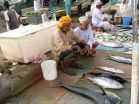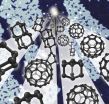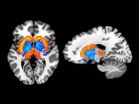(Press-News.org) A growing "dead zone" in the middle of the Arabian Sea has allowed plankton uniquely suited to low-oxygen water to take over the base of the food chain. Their rise to dominance over the last decade could be disastrous for the predator fish that sustain 120 million people living on the sea's edge.
Scientists at Columbia University's Lamont-Doherty Earth Observatory and their colleagues are the first to document the rapid rise of green Noctiluca scintillans, an unusual dinoflagellate that eats other plankton and draws energy from the sun via microscopic algae living within its cells. Noctiluca's thick blooms color the Arabian Sea an emerald green each winter, from the shores of Oman on the west, to India and Pakistan on the east.
In a study published this week in Nature Communications, the researchers show how the millions of green algae living within Noctiluca's cells allow it to exploit an oxygen-starved dead zone the size of Texas. They hypothesize that a tide of nutrient-rich sewage flowing from booming cities on the Arabian Sea is expanding the dead zone and feeding Noctiluca's growth.
"These blooms are massive, appear year after year, and could be devastating to the Arabian Sea ecosystem over the long-term," said the study's lead author, Helga do Rosario Gomes, a biogeochemist at Lamont-Doherty.
Until recently, photosynthetic diatoms supported the Arabian Sea food chain. Zooplankton grazed on the diatoms, a type of algae, and were in turn eaten by fish. In the early 2000s, it all changed. The researchers began to see vast blooms of Noctiluca and a steep drop in diatoms and dissolved oxygen in the water column. Within a decade, Noctiluca had virtually replaced diatoms at the base of the food chain, marking the start of a colossal ecosystem shift.
Green Noctiluca lives in the tropics while its close relative, red Noctiluca scintillans, whose blooms can sometimes kill fish with their high ammonia content, prefers temperate waters. Green Noctiluca is remarkably willing to eat anything. It feeds on other plankton, living or dead, flushing diatoms and other plankton into its gullet with a flick of its flagellum. It also draws energy from the millions of green algae, or "endosymbionts," living within its transparent cell walls. The algae fix carbon from sunlight and pass the energy, like rent, on to their host.
A varied diet gives Noctiluca its edge. "They can swim down to find nutrients, up to find light, and they can eat other small organisms," said Sharon Smith, a plankton ecologist at the University of Miami who works in the Arabian Sea but was not involved in the study.
To understand the key to Noctiluca's success, the researchers spent three successive winters aboard the Indian research ship Sagar Sampada, starting in 2009. Sailing off the coast of Goa, they sampled blooms and performed experiments. Putting Noctiluca and its diatom competitors in oxygen-starved water they found that Noctiluca's carbon-fixation rate rose by up to 300 percent while the diatoms' fell by nearly as much. They also found Noctiluca grew faster in light than in dark, thanks to its sun-loving endosymbiont-algae, which are thought to have evolved 1.3 billion years ago on an oxygen-scarce Earth.
The researchers tried to also identify Noctiluca's predators. They had heard reports of Omani fishermen seeing more gelatinous salps, jellyfish and sea turtles. Could they be eating the Noctiluca? Scooping up several salps from the sea, the researchers dropped them into buckets of seawater thick with Noctiluca blooms. In an hour, the water became visibly clearer. By measuring the drop in chlorophyll, the researchers estimated that one salp can polish off about two-thirds of a bucket of Noctiluca in an hour.
"They chowed on Noctiluca, like rabbits in a lettuce patch," said Gomes. "This is a creature that few other marine animals want to eat."
Noctiluca is too big for the crustacean grazers that normally feed on diatoms, leading to concerns that it could spawn an alternate food chain lacking the predator fish people like to eat. Many fisheries in the Arabian Sea are already on a slow decline. Eighty-five percent of fishermen surveyed in the fishing-dependent states of Tamil Nadu and Maharashtra in India reported a smaller catch from 20 years and 12 years earlier, according to a 2014 study in the journal Oryx. Similarly, a rise in puffer fish off the coast of the Indian state of Kerala has been attributed to a crash in predator cobia fish since 2007, according to a 2013 study in Current Science. In Oman, the catch of large fish fell 18 percent in 2013 from the year before, the Times of Oman reported.
Whether Noctiluca or overfishing is to blame, one major factor stands out: massive sewage flows into the Arabian Sea as the coastal population has exploded. As the study authors point out, Mumbai's population has doubled to 21 million in the last decade. The region now sends 63 tons of nitrogen and 11 tons of phosphorus into the Arabian Sea each day. Karachi's 15 million people send 70 percent of their wastewater into the sea untreated. Much of the fertilizer used to boost yields on farms in South Asia also eventually washes into rivers that drain into the sea.
"All of these cities are growing so rapidly they don't have the capacity to treat their sewage," said study coauthor Joaquim Goes, a biogeochemist at Lamont-Doherty. "The amount of material being discharged is humongous."
From the Gulf of Mexico to Chesapeake Bay, dead zones and degraded fisheries are on the rise globally. Doubling in size each decade, and now covering more than 95,000 square miles, they are "probably a key stressor on marine ecosystems," according to a 2008 study in Science. Shifting ocean currents due to climate change can make the problem worse by dredging up nutrients from the ocean bottom.
In the Arabian Sea, stronger summer monsoon winds have boosted algae growth by bringing more nutrients from the deep ocean to the surface. In a 2005 study in Science, Goes, Gomes and colleagues showed that biomass from summer blooms off Somalia, Yemen and Oman, jumped nearly 350 percent between 1997 and 2004. They hypothesize that receding snow cover in the Himalaya-Tibetan plateau is making the Indian subcontinent hotter in summer compared to the Arabian Sea, strengthening the winds that blow toward India, bringing up more nutrients off Somalia, Yemen and Oman.
The researchers expected gentler monsoon winds in winter, as the process reversed itself, leading to fewer algae blooms. But NASA satellite maps showed just the opposite: more winter blooms. After several years of sampling what they thought were sporadic Noctiluca blooms, the researchers realized in 2006 that the blooms seen from space were not diatoms but recurring Noctiluca blooms.
They wondered if falling oxygen levels could explain the diatom-to-Noctiluca shift. Sure enough, the experiments aboard the Sagar Sampada seemed to confirm their hypothesis.
The study has attributed much of Noctiluca's rise to growing sewage flows into the Arabian Sea, an intriguing connection that should be followed up on, says Andrew Juhl, a microbiologist at Lamont-Doherty who was not involved in the study. "It's unusual for Noctiluca to bloom in the open sea and return year after year," he said "All of these observations suggest that something dramatic has changed in the Arabian Sea."
INFORMATION:
The study was funded by the National Science Foundation, NASA, Indian Space Research Organization and India's Council of Industrial Research. Other authors: Prabhu Matondkar, National Institute of Oceanography in Goa; Edward Buskey, University of Texas at Austin; Subhajit Basu, Goa University; Sushma Parab, Kent State University and Prasad Thoppil, Stennis Space Center.
Shift in Arabia sea plankton may threaten fisheries
Growing 'dead zone' could short-circuit food chain
2014-09-09
ELSE PRESS RELEASES FROM THIS DATE:
Buckyballs and diamondoids join forces in tiny electronic gadget
2014-09-09
Menlo Park, Calif. — Scientists have married two unconventional forms of carbon – one shaped like a soccer ball, the other a tiny diamond – to make a molecule that conducts electricity in only one direction. This tiny electronic component, known as a rectifier, could play a key role in shrinking chip components down to the size of molecules to enable faster, more powerful devices.
"We wanted to see what new, emergent properties might come out when you put these two ingredients together to create a 'buckydiamondoid,'" said Hari Manoharan of the Stanford Institute for Materials ...
Eating habits, body fat related to differences in brain chemistry
2014-09-09
People who are obese may be more susceptible to environmental food cues than their lean counterparts due to differences in brain chemistry that make eating more habitual and less rewarding, according to a National Institutes of Health study published in Molecular Psychiatry.
Researchers at the NIH Clinical Center found that, when examining 43 men and women with varying amounts of body fat, obese participants tended to have greater dopamine activity in the habit-forming region of the brain than lean counterparts, and less activity in the region controlling reward. Those ...
Study sheds light on how stem cells can be used to treat lung disease
2014-09-09
Munich, Germany: A new study has revealed how stem cells work to improve lung function in acute respiratory distress syndrome (ARDS).
Previous studies have shown that stem cells can reduce lung inflammation and restore some function in ARDS, but experts are not sure how this occurs. The new study, which was presented at the European Respiratory Society's International Congress today (09 September 2014), brings us a step closer to understanding the mechanisms that occur within an injured lung.
ARDS is a life-threatening condition in which the efficiency of the lungs ...
Birth measurements could predict lung health in teen years
2014-09-09
Munich, Germany: A new study has found that factors, such as birth weight, gestational age at birth and lung function, growth and other measures at 8 years, can be used to predict lung function during mid to late teenage years.
The study, presented at the European Respiratory Society (ERS) International Congress in Munich today (9 September 2014), is part of a growing area of research aiming to understand how early life factors have an impact on the development of disease into adulthood.
Data out of the Avon Longitudinal Study of Mothers and Children (ALSPAC) from ...
Idiopathic pulmonary fibrosis cases linked with asbestos exposure
2014-09-09
Munich, Germany: A proportion of idiopathic pulmonary fibrosis (IPF) cases may be linked with asbestos exposure, according to the results of a new study. If confirmed, the findings would mean that current treatment strategies need to be altered as people with a history of asbestos exposure are not currently able to access new treatments for IPF.
The research, which was presented at the European Respiratory Society's International Congress today (09 September 2014), provided new mortality data for IPF, asbestosis and mesothelioma.
Asbestosis is the name given to the ...
Milestone reached in work to build replacement kidneys in the lab
2014-09-09
WINSTON-SALEM, N.C. – Sept. 9, 2014 – Regenerative medicine researchers at Wake Forest Baptist Medical Center have addressed a major challenge in the quest to build replacement kidneys in the lab. Working with human-sized pig kidneys, the scientists developed the most successful method to date to keep blood vessels in the new organs open and flowing with blood. The work is reported in journal Technology.
"Until now, lab-built kidneys have been rodent-sized and have functioned for only one or two hours after transplantation because blood clots developed," said Anthony ...
Intervention in 6-month-olds with autism eliminates symptoms, developmental delay
2014-09-09
Treatment at the earliest age when symptoms of autism spectrum disorder (ASD) appear – sometimes in infants as young as 6 months old – significantly reduces symptoms so that, by age 3, most who received the therapy had neither ASD nor developmental delay, a UC Davis MIND Institute research study has found.
The treatment, known as Infant Start, was administered over a six-month period to 6- to 15-month-old infants who exhibited marked autism symptoms, such as decreased eye contact, social interest or engagement, repetitive movement patterns, and a lack of intentional communication. ...
Contrast-enhanced CT scan safe for most patients
2014-09-09
OAK BROOK, Ill. – According to new research performed at the Mayo Clinic, iodine-based contrast material injected intravenously to enhance computed tomography (CT) images can be safely used in most patients. The study appears online in the journal Radiology.
Of the 80 million or more CT scans performed each year in the United States, iodine-based contrast material is used in at least half to enhance computed tomography (CT) images, according to researcher Robert J. McDonald, M.D., Ph.D., a radiology resident at the Mayo Clinic in Rochester, Minn.
According to Dr. McDonald, ...
IU study links skipping school, failing tests to more sex, less condom use in teenagers
2014-09-09
INDIANAPOLIS -- What do skipping school, failing tests and engaging in risky sexual behavior have in common? Lots, according to Indiana University researchers who combed through 80,000 diary entries written by 14- to 17-year-old girls.
Although the findings are intuitive, this is the first study to examine the day-to-day relationship between teenage girls' reports about school-related events, how they felt and the sexual behaviors they participated in. Published Sept. 9 in the Journal of Adolescent Health, the findings are based on a 10-year study of the development of ...
Researchers identify novel virus that could cause respiratory disease in ball pythons
2014-09-09
Researchers have identified a novel virus that could be the source of a severe, sometimes fatal respiratory disease that has been observed in captive ball pythons since the 1990s. The work is published this week in mBio®, the online open-access journal of the American Society for Microbiology.
Investigators observed the virus, which they named ball python nidovirus, in eight snakes with pneumonia; virus levels were highest in the animals' lungs and other respiratory tract tissues. The team also sequenced the genome of the virus, finding it to be the largest of any RNA ...
LAST 30 PRESS RELEASES:
Key lung immune cells can intensify allergic reactions
Do hormones explain why women experience more gut pain?
New materials conduct ions in solids as easily as in liquids
Breakthrough of the Year: Renewable energy begins to eclipse fossil fuel-based sources
LLM use is reshaping scientific enterprise by increasing output, reducing quality and more
Introducing LightGen, a chip for ultra-fast, ultra-efficient generative AI
Astronomers see fireworks from violent collisions around nearby star
ACC/AHA issue new guideline on managing congenital heart disease in adults
Cosmic crash caught on camera
Is talented youth nurtured the wrong way? New study shows: top performers develop differently than assumed
Ants: An untapped resource in the development of antibiotics?
Archaeologists use AI to create prehistoric video game
Mitochondria migrate toward the cell membrane in response to high glucose levels
Tiny viral switch offers hope against drug-resistant bacteria
Most parents aware of early peanut introduction guidelines, but confused about details
HPV vaccine can protect against severe lesions of the vulva and vagina
Virtual care provision and emergency department use among children and youth
Quadrivalent HPV vaccine and high-grade vulvovaginal lesions
Insights into dry eyes gained from stem cell-derived tear glands
Researchers identify 166 human pluripotent stem cell lines available for use in clinical applications
Europa Clipper instrument uniquely observed interstellar comet 3I/ATLAS
UN University Report challenges climate change as sole trigger of Syrian Civil War, exposing governance failures in drought response
Real estate investment trust (REIT) acquisition associated with hospital closure and bankruptcy
New Raman imaging system detects subtle tumor signals
Boston Children’s receives a $7.5 million grant from Aligning Research to Impact Autism (ARIA) to provide clinical research coordination for the IMPACT Network
Spray-on antibacterial coating offers new protection for plants against disease and drought
ESMT Berlin study: What makes a first offer successful in negotiations
Groundbreaking ceremony marks the beginning of CTAO-South Array construction in Chile
Why swearing makes you stronger
What prevents more cancer patients from enrolling in potentially life-saving clinical trials?
[Press-News.org] Shift in Arabia sea plankton may threaten fisheriesGrowing 'dead zone' could short-circuit food chain



